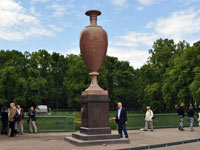Russia, 199034, St. Petersburg, Line 14th V.O., house 7, letter A, BC "Preobrazhensky"

(812) 322-09-40
(812) 322-34-40
Porphyry, application in architecture and landscape gardening
Porphyry is the general name for massive acidic acid rocks that have a porphyry structure - fine crystalline with large inclusions of various minerals. The strength of porphyry is almost twice that of granite. It is characterized by frost resistance, weathering resistance and low abrasion. With daily active operation in a through passage, for example, in subways and other similar places, granite tiles will serve for at least 7 years without any visible signs of wear, while porphyry will remain intact for more than 13 years. Another very rare for natural stones and useful in operation property is porphyry - the property of self-cleaning. A metamorphic rock, i.e. which has undergone certain transformations from the effect of pressure or temperatures, "occurred" from porphyry is quartzite. With its properties and features can be found in the article, by clicking on the link Shokshinsky quartzite.
In the beginning of the XVIII century, in the mountains and foothills of the Altai, deposits of colored stones, including porphyry, were discovered. However, for many years they remained unclaimed. Since 1786, after the porphyry of high quality in the gorge of the Korgon River was discovered by P.I. Shangin, the mining engineer of the Kolyvan-Voskresensky plants, after the Ober-Gittenfervalter (namely, the senior factory steward), mining operations began. Korgon porphyry found its application as an ornament to the rich palaces and luxurious mansions of the capital's nobility. He made bas-reliefs, sculptures, various small architectural forms.
According to the records of those years it is clear that the local porphyry had several differences: light purple, red, dark coffee and blue-violet. Mass extraction and use of the Korgon porphyry continued during the active construction of the new capital and ended after the abolition of serfdom, in connection with the disappearance of cheap labor. Until the end of the XIX blocks used in the 1830s-1850s were still used, but later the deposit was not developed due to inaccessibility and, consequently, high cost of work. But porphyry was and belongs to its decorative properties to decorative and highly decorative stones. As evidenced by its use in the most significant buildings, such as, for example, the memorial Cathedral of the Resurrection of Christ on the Blood, better known as the Church of the Savior on Blood in St. Petersburg.







 Site search
Site search


